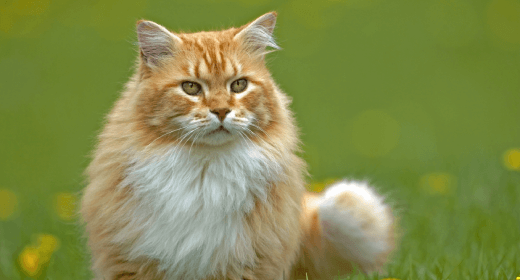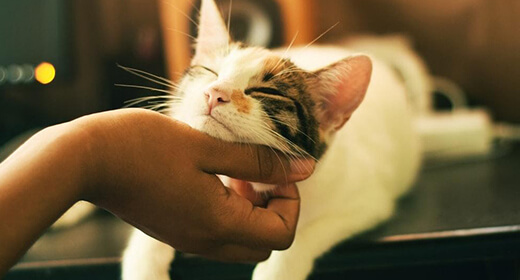

Nutrients such as protein, fat, vitamins, and minerals are important players in the skin and coat health of dogs and cats. To understand their role, it is necessary to first understand skin and hair.
The purpose of skin and hair is to block things (such as water or heat) from leaving, or things (such as viruses and bacteria) from entering the body.
The hair coat is composed almost entirely of protein. If an animal's diet doesn't contain adequate protein quantity and quality, hair may fall out, or become dry, weak, and brittle.
Skin is made up of squamous cells, which are flat cells tightly packed together. These cells have tough membranes that are composed of proteins and fats. Without proper amounts of these nutrients, cell membranes weaken, allowing water to escape and bacteria and viruses to enter more easily.
Proteins are found in both animal-based and plant-based ingredients. Animal-based proteins contain all the essential amino acids cats need, whereas plant-based proteins may contain only some essential amino acids. Cats need animal-based proteins to achieve optimal health.
Fats also can be found in both animal-based and plant-based ingredients, and they are incorporated into skin cells as fatty acids. There are two essential fatty acids for skin and coat health. Linoleic acid maintains skin and coat condition in dogs and cats. Without enough linoleic acid cats may experience dull, dry coat, hair loss, greasy skin and increased susceptibility to skin inflammation. Cats also require arachidonic acid for normal skin and coat health.
Both of these essential fatty acids are omega-6 fatty acids and are found in animal tissues such as chicken fat. Linoleic acid is also found in some vegetable oils, such as corn and soybean oils. Most commercial cat diets contain more than adequate amounts of omega-6 fatty acids.
Because these fatty acids can be converted to compounds that increase susceptibility to skin inflammation, it is important to balance the amount of omega-6 fatty acids in the diet with omega-3 fatty acids, which do not reduce susceptibility to inflammation.
Omega-3 fatty acids are found in oils from fish and some plants (canola and flax).
IAMS™ research has found that combining fat sources in the diet at a ratio of five to 10 omega-6 fatty acids to one omega-3 fatty acid results in excellent skin and coat health.
Vitamins and minerals are essential for the development of healthy skin and hair coat. The best way to provide these nutrients is through a complete and balanced diet containing appropriate amounts of essential vitamins and minerals rather than through supplements.
| Vitamin or Mineral | Important for Skin and Coat Health |
|---|---|
| Vitamin A | Necessary for growth and repair of skin |
| Vitamin E | Protects skin cells from oxidant damage |
| Biotin | Aids in the utilization of protein |
| Riboflavin (B2) | Necessary for fat and protein metabolism |
| Zinc | Necessary for fat and protein metabolism |
| Copper | Involved in tissue, pigment, and protein synthesis |
Diet is often believed to be a factor when changes in skin and coat condition are noticed. The most common causes of these changes, however, are season and life stage.
As cold weather approaches, most dogs and cats grow a thick coat to help keep heat in and cold air out. As the weather begins to warm up, they shed the thick, heavy coat.
Most kittens are born with soft, fuzzy hair, but as they age, a coarser coat grows. Pregnant or lactating cats also may experience a change in coat condition or hair loss.


Cats are known to be solitary creatures and enjoy spending time with themselves. However, as a pet parent, you must ensure that your cat remains healthy. It is advisable to keep an eye on your cat’s behaviour to detect a sudden change, even what it eats, and in how much quantity. A regular health checkup is one of the most basic yet essential steps to a cat care guide. Taking care of cats is comparatively easier than taking care of kittens. A diligently followed routine for cat care can also be quite helpful.
Medical care: Adult cats should be taken to the vet for a complete checkup at least once a year. This will ensure that your cat is in good health and will also catch any disease symptom overlooked by you.
Hygiene: Cats usually lick and clean themselves, but it is always advisable to bathe your cat every 4-6 weeks. Their crates should also be cleaned regularly to make sure they do not fall sick.
Feeding: Till the time your kitten is four months old, it can be fed three times a day. Post four months, you can begin the transition to feeding it twice a day. It is still advisable to consult a vet before deciding the frequency of the meals.
Dental care: Your cat’s dental care is just as important as yours. It is advisable to set a dental care routine right from its kitten phase. You can dip your gloved finger in a little toothpaste made for cats in its mouth to clean their teeth and gums. If your cat’s mouth smells bad, it may be an indication of a disease. So, book an appointment with your vet without any delay.
Socialising: You can get your cat to socialise too, but you have to keep a few things in mind. You may get down to its level to initiate contact and speak in a calm voice. You may also pat its head to let it get familiarised with your touch.
Now that you have brought your cat home, the next step is to comfortably settle it in your house. Housetraining might sound like a tedious task but it isn’t. With a little practise and lots of patience, you can easily housetrain your cat. Some of the most basic things to keep in mind while housetraining your cat include providing a proper litter box, spaying your cat, toilet training and cat proofing the house. Given below are some tips that may help you easily housetrain your cat:
Litter box: It is advisable to place the litter box in an easily accessible location. You should avoid moving the litter box unless necessary. And even if you have to move it, shift it a few inches every day. Also, keep in mind that your cat will not use a dirty or smelly litter box. Hence, scoop out the solid waste at least once a day and clean it using mild detergents.
Cat-proofing: It is important that you keep harmful things out of reach from your cat. First and foremost, tie up all loose cables and wires so that your cat won’t get tangled in them. Make sure candles and other flaming substances are kept at an unobtainable distance from the cat. If you use essential oils frequently, make sure your cats do not come in contact with them either, because certain ingredients in these oils may be toxic for your feline friend.
Spaying: Spaying your cat has several health benefits and ensures your cat lives a healthy life. You may fix an appointment to spay your kitten when it is as young as eight weeks old. If you have a cat, it is advisable to get it spayed before it reaches five months of age.
Toilet training: This is one of the major concerns of all cat parents. Here’s how you can toilet-train your cat with a few simple steps –
1) Place the cat’s litter box closer to the washroom.
2) Raise the height of the litter box a little every day.
3) Slowly, transition your cat to use the actual washroom every time it wants to go.
4) Give your cat a treat each time it uses the washroom. This will encourage good behaviour.
Taking care of your cat’s health comes first in the cat care guide. Even though cats lick and self-groom themselves, they cannot get better on their own if they contract the following diseases:
Vomiting: This is one of the most common health issues in cats and is caused by various factors. Hairballs, eating something inedible, or a urinary tract infection are some of the reasons why your cat may be vomiting.
Feline Lower Urinary Tract Diseases (FLUTD): Both male and female cats can contract FLUTD and its main cause is obesity or only eating dry food. Some of the symptoms of FLUTD are bloody urine, crying while urinating, straining to pee, licking around the urinary area due to pain, dehydration and vomiting.
Diarrhoea: Cancer, infection, allergy and bad food can be the causes of diarrhoea. It is advisable to give your cat a lot of fresh water to drink if it has diarrhoea.
Tapeworms: Tapeworms can cause extreme discomfort to your cat as they reside in its intestines. You can spot tapeworms with your naked eye in your cat’s stools. The symptoms of worms are vomiting and weight loss.
Feline Immunodeficiency Virus (FIV): This virus can make the immune cells attack the white blood cells in the cat’s body. This gradually weakens the cat’s immune system. FIV’s symptoms are poor coat condition, persistent diarrhoea, seizures, eye problems, lack of appetite, and recurring fever.
If you notice unaccountable minor changes in your cat, then it is advisable to rush to the vet to rule out any of the above-mentioned diseases and seek proper treatment on time.
‘How to take care of a cat’ is a question asked by many first-time cat owners, as cats can be difficult to figure out. But with a few careful steps, you can easily take care of your cat. Here are some cat care tips for first-time cat owners:
Cats are not easily adaptive to change. So, when you bring your cat home for the first time, you need to help it familiarise with the new surroundings by setting up its own space in the house. You can also add a cheery vibe to its crate by adding toys and a blanket.
Find a vet you can visit for your cat’s timely checkups. It is not advisable to ignore even the smallest recognised change in its health, and it is better to get it checked by the vet.
Cats love quality playtime as well. We recommend you get adorable toys for your feline friend to play with. You, too, can bond with your cat during this time.
Give it time to adapt to its new surroundings and the new people around them.
Ensure you buy healthy cat food for your new friend in advance and set a timetable for its meals.